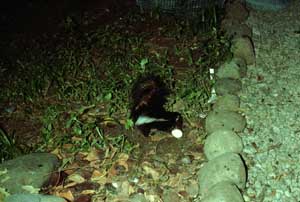|
|
 48 warning colors DHJanzen100212.jpg high resolution
|
|
|
We have now seen many examples of warning colors, the colors of aposematic insects. But, these colors are not restricted to insects. Think about the mammals that you know, and which are very ostentatiously colored/patterned. The skunk (of which there are many species in several families of mammals) comes immediately to mind. Its brilliant white on jet black sends a message - leave me alone. Its plume-like tail held aloft elaborates the message. But why is it black and white, rather than red/orange/yellow? There are probably several reasons. First, many of the potential predators on skunks - dogs, cats, other mustelids, viverids - are probably colorblind or nearly so. To a colorblind animal, black and white are very visible flags to contrast with the grays of the rest of the world (to a colorblind animal, the world is mostly shades of gray). Second, skunks the world over range from dusk/dawn low light activity, to nocturnal (and in the moonlight). In low light intensity, even vivid colors often become grayish and hard to distinguish by an animal with color vision. Skunk black/white patterns have evolved independently over and over in various families of animals that have evolved chemical defenses. There are even rodents that are black and white harmless batesian mimics of skunks. As an aside, the hooded skunk (Mephitis macroura) in this Costa Rican photograph has a chicken egg, and is confronted with the puzzle of how to get into it. The puzzle is solved the way skunks (and probably some other predators on the ground) have solved this puzzle around the world. The skunk throws the egg with its forelegs violently between its forelegs under its belly in hopes of hitting a rock somewhere behind it. After throwing, it turns and looks for the results. If there are none, it repeats, and repeats, and repeats until success is achieved. Sort of like a multiple choice question. |
||
back to lecture slides
or skip to: